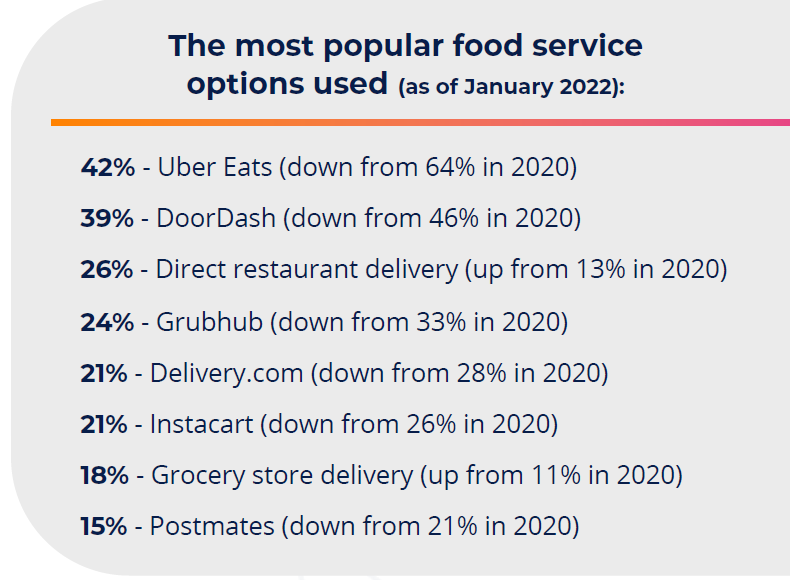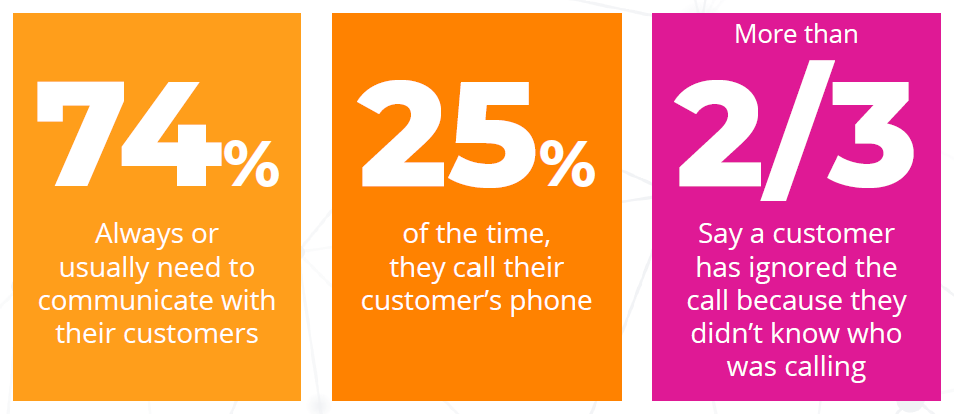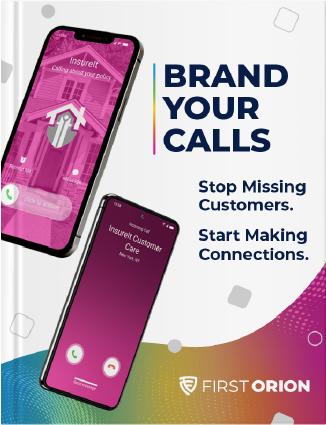Survey statistics and real-life experiences from consumers and food delivery drivers
In Q4 2021, we surveyed 5,000 U.S. residents about their experiences with calls from food delivery services to their mobile phones. Specifically, they were asked about call activity, call type, brands they interact with, their perception of those brands based on their calling behavior, and their preferences in relation to these experiences. A similar survey was conducted in July 2020.
Comparisons between the two surveys are noted (where relevant) as some consumer behaviors and preferences have changed over the course of the COVID-19 pandemic.
All 50 states were represented and male/female split was nearly even, with 1% choosing “other.”
We also surveyed 500 respondents who identified as drivers for a mobile delivery service (i.e., Uber Eats, Grubhub, DoorDash, etc.).
Key Findings
The food delivery experience – according to both customers and drivers – can be improved through clarity and consistency in communications.
- More than 3 in 4 people responded that they had experienced some form of issue with a food delivery service.
- Over 60% of people said they missed a call from a food delivery/pickup service because they didn’t recognize the incoming number.
- Nearly 3 in 4 food delivery drivers said they “always” or “usually” have to communicate with the customers they were delivering to.
- More than 67% of delivery drivers said a customer ignored their call because customers didn’t know who was calling them.
Food Delivery Trends

Times are a-changing for the food and restaurant delivery industry. In 2020, the COVID-19 pandemic created a boom for food delivery and grocery shopping services due to public health restrictions and consumer caution.
However, in late 2021 and early 2022, people’s preferences for delivery services are changing. Many are being more scrupulous, making fewer take-out food delivery orders and replacing it with grocery orders. Nevertheless, nearly 90% of people said they had used a food delivery service within the past 90 days.
Though there has been a general decline since the 2020 survey, delivery services remain incredibly popular. Now ingrained in the dining experience, food delivery services need to embrace the demand for better customer service and improved communication.
The most popular food service options used (as of January 2022):
- 42% – Uber Eats (down from 64% in 2020)
- 39% – DoorDash (down from 46% in 2020)
- 26% – Direct restaurant delivery (up from 13% in 2020)
- 24% – Grubhub (down from 33% in 2020)
- 21% – Delivery.com (down from 28% in 2020)
- 21% – Instacart (down from 26% in 2020)
- 18% – Grocery store delivery (up from 11% in 2020)
- 15% – Postmates (down from 21% in 2020)
Late Food = Bad Mood
“Good service can save a bad meal, but there is no level of food that can save bad service.” – Alton Brown, renowned chef and TV personality
Food can be the great uniter. Food service? The great divider.
If you’ve ever dealt with a hangry (hungry + angry) person, you understand why people insist that their orders be on time. They also expect the quality to be good.
Food delivery is all about the convenience and people pay delivery rates to save themselves time (time from cooking, or time from rushing out to pick up the order).
With that in mind, 79% of people responded that they had some form of issue that required customer service.
The top five reported issues:
- Late delivery
- Food quality (taste/freshness issues)
- Incorrect order
- Food order never arrived
- Driver required assistance (directions/lost/access)
Fix It, Fast
Great customer service in the delivery industry is reliant on open communication and timeliness.
More than three-quarters of people reported that they’ve had some form of issue with a food delivery service. When there’s a problem, the quicker the communication, the better.
There’s no faster, more urgent form of communication than a phone call. Emails are slow and cumbersome in comparison and many people miss text messages.
With punctuality in mind, when do people want a phone call? Not surprisingly – when there’s an issue with an order (93%) or when the driver needs help (59%).
The Unanswered Dinner Bell
However, it’s hard to fix an urgent issue when the customer doesn’t answer their phone.
In fact, over 61% of respondents said they missed a call because it wasn’t properly identified and more than half (56%) said a missed call about their food delivery created a bad experience.
What restaurants and delivery services may not realize is that bad service – especially in the form of bad or nonexistent communications – could cost them customers.
More than two-thirds of people (68%) said they would consider switching to a delivery service that could properly identify its phone calls.
Not to be Taken with a Grain of Salt – Customers Share Delivery Dilemmas
“My house is situated in the courtside of a small two-spaced neighborhood – streetside & courtside. A delivery driver who’s unfamiliar with this address may not identify the entry needed to access the courtside where my house is situated … I have had food delivery drivers and the postal service get confused about finding my house … I don’t answer the phone, not ever, unless I recognize the phone number.”
“The order was needing several substitutions because the restaurant was out of certain items, but I missed the call and the restaurant substituted what they wanted. The overall order was horrible.”
“I forgot to change the delivery address after I moved. The driver called me several times, but I didn’t answer since there are too many scam calls every day. Then the driver contacted me from his delivery platform customer service. I told the customer my new address, so the delivery took much longer than I expected.”
“There was a substitution that was needing my approval. I did not recognize the number, so I did not answer. Instead of leaving a voicemail or text they got something completely different. It was one of the main items I was needing.”
From the Other Side – Drivers Give Their Insights
Deliveries don’t always go as planned. Despite great technological advances on mobile devices, some homes can be difficult to find, or they may have barriers to access. Or there may have been an issue with an order that caused the driver to be late.
Regardless of reason, nearly three-quarters of delivery drivers said they “always” or “usually” need to communicate with their customers.
Drivers said that they use a mobile phone call 25% of the time to communicate with their customers; however, 69% of drivers said they had a call ignored because the customer didn’t know who was calling.
- 74% always or usually need to communicate with their customers
- 25% of the time, they call their customer’s phone
- More than 2/3 say a customer has ignored the call because they didn’t know who was calling
Remember that 56% of people say that a missed call could create a negative experience with the delivery service.

True Tales from Behind the Wheel
Drivers share their tales of negative or less than optimal experiences when contacting their delivery clients.
“There was an issue with a customer order that I tried to contact them about, but they never answered. They ended up leaving me a negative review because they assumed I chose to not deliver their order… they closed my account to be a delivery driver.”
“Waited for a very long time to get in touch with a customer in an area that had very little parking. It was terrible. She wouldn’t answer the phone and I had to wait as per the guidelines for at least 15 minutes for this customer.”
“I couldn’t get into the building to deliver their food and they were not answering their calls. The signal in the area was bad so I couldn’t even take a picture of where I left the food, which was outside the front door of the building.”
“I delivered the food to the wrong person because they would not pick up the phone and someone else took it.”
Branded Communication
First Orion’s Branded Communication solutions deliver calls made to answer. Our clients have seen a 76% lift in first-call conversions using our solutions, resulting in increased productivity, more revenue, and higher client satisfaction.
Our text-based INFORM® solution offers a 32-character customizable display. Share your name and message so your customers know who’s calling and why. INFORM does not require any additional technology to implement.
ENGAGE® is a graphics-based display that requires an SDK through a mobile app. ENGAGE calls can display your name, logo, brand colors, and messaging – right on your customers’ mobile device.
Discover how you can make the connection. Visit firstorion.com/branded-communication today. Or jump straight to the good stuff and get started!




